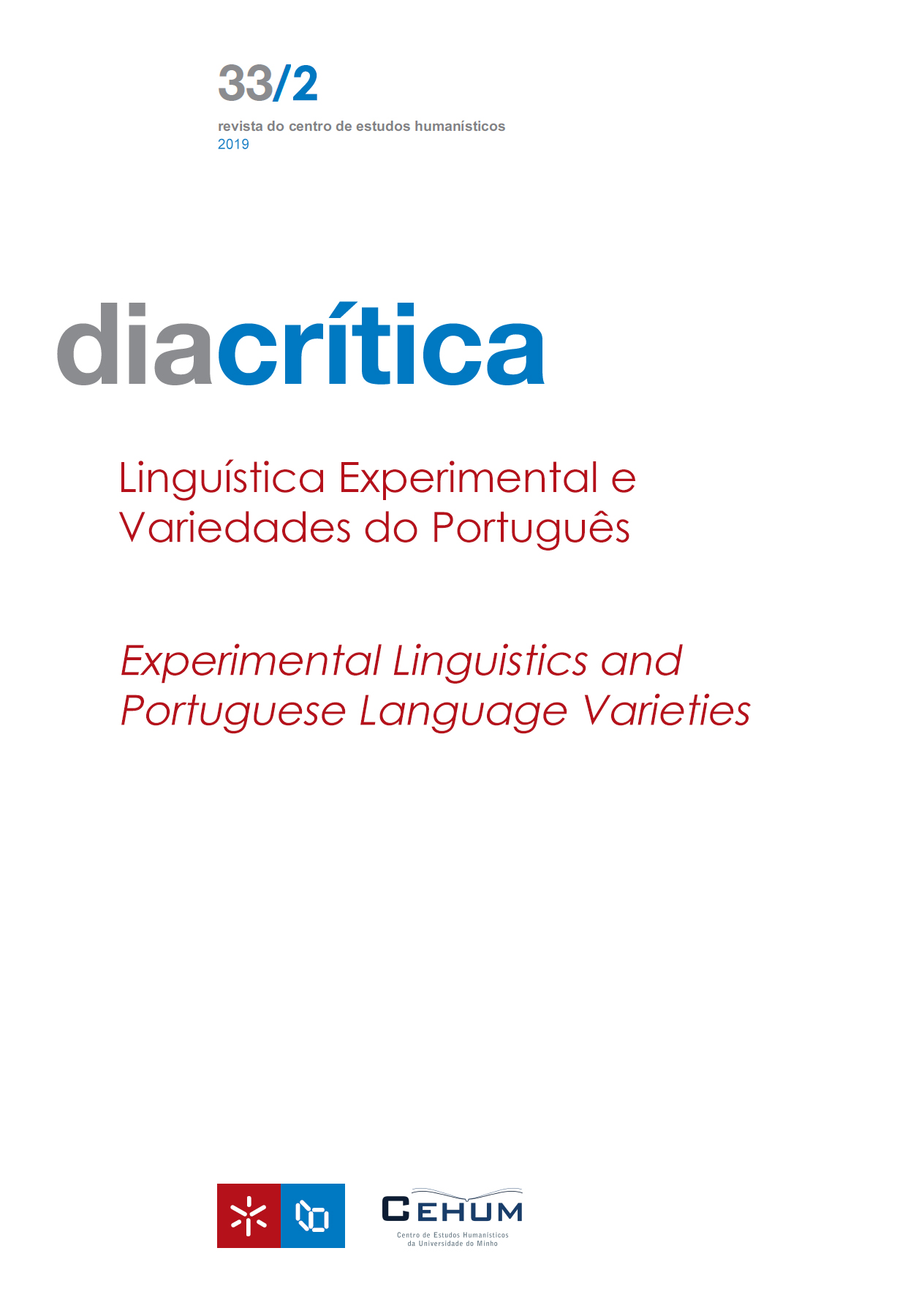Transferência reversa e colocação clítica um estudo com bilíngues Português Brasileiro e Espanhol
DOI:
https://doi.org/10.21814/diacritica.5058Palavras-chave:
Colocação clítica, Transferência reversa, Português, EspanholResumo
Este artigo trata de transferência reversa, isto é, a influência da L2 na L1, em situação de dominância da L1. Investiga-se a colocação pronominal clítica em complexos verbais no português brasileiro (PB) e no espanhol. O espanhol privilegia a próclise ao verbo auxiliar (posição pré-verbal/subida do clítico) ou a ênclise ao verbo principal (posição pós-verbal). O PB, por sua vez, perdeu a subida do clítico no século XIX. Embora a escola tente recuperar seu uso, a fala natural privilegia a próclise ao verbo principal (posição medial). Assim, em princípio, pode-se admitir que falantes escolarizados do PB aceitem a ordem com a subida do clítico. Por outro lado, uma aceitação plena da subida do clítico pode constituir um caso de transferência reversa, no contexto de falantes bilíngues de PB/espanhol. A fim de observar esse quadro, aplicou-se uma tarefa de leitura automonitorada com escala Likert para julgamento de gramaticalidade, manipulando a posição do clítico, em sentenças em português, a monolíngues de PB com alta escolaridade e bilíngues PB/espanhol. Os resultados demonstram que ambos grupos aceitam a subida do clítico, mas os bilíngues apresentam maior aceitação e são mais rápidos na leitura das sentenças em português com subida do clítico, sugerindo uma possível facilitação do espanhol no processamento de sentenças em português.
Referências
Chomsky, N. (1981).Lectures on Government and Binding. Dordrecht, Netherlands: Foris.
Cook, V. (1991). The poverty-of-the-stimulus argumentandmulticompetence.Interlanguage Studies Bulletin (Utrecht),7(2), 103–117. https://doi.org/10.1177/026765839100700203 DOI: https://doi.org/10.1177/026765839100700203
Cook, V. (2003). Effects of the Second Language on the First. Clevedon: Multilingual Matters. DOI: https://doi.org/10.21832/9781853596346
Duarte, M. E. L. (2000). The loss of the Avoid Pronoun principle in Brazilian Portuguese. In M.A.Kato&E.V.Negrão(Eds.),Brazilian Portuguese and the null subject parameter(pp. 17–36). Frankfurt: Vervuert-Iberoamericana. DOI: https://doi.org/10.31819/9783964561497-002
Gonçalves, A. & Leitão, M. (2011). O processamento de orações relativas com e sem o pronome “that” por brasileiros aprendizes tardios de inglês como L2. Organon,51, 129–144.https://doi.org/10.22456/2238-8915.28837 DOI: https://doi.org/10.22456/2238-8915.28837
González, N. T. (1994). Cadê o pronome? O gato comeu: Os pronomes pessoais na aquisição/aprendizagem do espanhol por brasileiros adultos(Unpublished Doctoral thesis, São Paulo University, São Paulo, Brasil).
Holmberg, A., Nayudu, A. & Sheehan, M. (2009). Three partial null subject languages: Acomparison of Brazilian Portuguese, Finnish and Marathi. StudiaLinguistica, 63(1), 59–97.htps://doi.org/10.1111/j.1467-9582.2008.01154.x DOI: https://doi.org/10.1111/j.1467-9582.2008.01154.x
Jarvis, S. (2003). Probing the effects of the L2 on the L1: a case study. In V. Cook (Ed.),Effects of the second language on the first(pp. 81–102). Clevedon: Multilingual Matters. DOI: https://doi.org/10.21832/9781853596346-007
Kayne, R. (1989). Null subjects and clitic climbing. In O. Jaeggli & K. Safir (Eds.),The null subject parameter (pp. 239–261). Dordrecht: Reidel. DOI: https://doi.org/10.1007/978-94-009-2540-3_8
Kato, M. A. (2000). The partial pro-drop nature and the restricted vsorder in Brazilian Portuguese. In M.A. Kato & E.V. Negrão (Eds.),Brazilian Portuguese and the null subject parameter(pp. 223–258).Frankfurt: Vervuert-Iberoamericana. DOI: https://doi.org/10.31819/9783964561497-011
Kato, M. A. (2005). A gramática do Letrado: questões para a teoria gramatical. In M. A. Marques, E. Koller,J.Teixeira & A. Lemos (Eds.),Ciências da Linguagem: Trintaanos de investigação e ensino(pp.131–145). Braga: CEHUM.
Kato, M. A. & Duarte M. E. L. (2014). Restrições na distribuição de sujeitos nulos no Português Brasileiro. VEREDAS, 18(1), 1–22.
Kecskes, I.& Papp, T. (2003). How to Demonstrate the Conceptual Effect of the L2 on L1?.In V. Cook (Ed.),The Effect of L2 on L1(pp. 247–265). Clevedon: Multilingual Matters. DOI: https://doi.org/10.21832/9781853596346-015
Odlin, T. (1989). Language transfer: Cross-linguistic Influence in language learning.Cambridge: Cambridge University Press. DOI: https://doi.org/10.1017/CBO9781139524537
Pavlenko, A. (2000). L2 influence on L1. Late bilingualism Issues in Applied Linguistics,11(2), 175–205.Retrieved from https://escholarship.org/uc/item/7gs944m5 DOI: https://doi.org/10.5070/L4112005033
Pagotto, E. (2013). A norma das constituições e a constituição da norma no século XIX. Revista Letra, 8(1), 31–50.https://doi.org/10.17074/rl.v1i0.27 DOI: https://doi.org/10.17074/18065333.2013v8n1p31
Raposo, E. (1998). Definite/zero alternations in Portuguese: Towards a unification of topic constructions. In A. Schwegler,B.Tranel& M. Uribe-Etxebarria (Eds.),RomanceLinguistics: Theoretical perspectives. Selected papers from the 27th Linguistic Symposium on Romance Languages(pp.197–212). Amsterdam: John Benjamins. DOI: https://doi.org/10.1075/cilt.160.16rap
Rodríguez-Mondoñedo, M., Snyder, W.& Sugisaki, K. (2006). Clitic-climbingin child Spanish and the theory of parameters. In A. Brugos, M. R. Clark-Cotton& S. Ha (Eds.),A supplement to the proceedings of the 29th Boston Universityconference on language development.
Selinker, L. (1972). Interlanguage. IRAL, 10(3), 209–231. DOI: https://doi.org/10.1515/iral.1972.10.1-4.209
Souza, R. & Oliveira, F. (2011).Is knowledge of a non-dominant L2 activated by bilinguals using their dominant L1: insights form an on-line psycholinguistic study. Organon,51, 103–128.https://doi.org/10.22456/2238-8915.28836 DOI: https://doi.org/10.22456/2238-8915.28836
Souza, R., Oliveira, C., Passos, M.& Almeida, L. (2014). Efeitos do bilinguismo sobre a L1: evidências em julgamentos de aceitabilidade e no processamento online de bilíngues em imersão na L2 ou não. Linguística, 10(1),193–212.
Uriagereka, J. (1995). An F position in western romance. In K. Kiss(Ed.),Discourse configurational languages(pp. 153–175).New York: Oxford University Press.
Weinreich, U. (1953). Languages in contact: Findings and problems. New York:Linguistic Circle of New York.
Wexler, K. (1996). The development of inflection in a biologically based theory of language acquisition. InM. L. Rice (Ed.),Toward a genetics of language(pp. 113–144).Hillsdale, NJ: Lawrence Erlbaum Associates, Inc.
Wexler, K. (1998). Very early parameter setting and the unique checking constraint: A new explanation of the optional infinitive stage. Língua, 106, 23–79.https://doi.org/10.1016/S0024-3841(98)00029-1 DOI: https://doi.org/10.1016/S0024-3841(98)00029-1
Downloads
Publicado
Como Citar
Edição
Secção
Licença
Direitos de Autor (c) 2023 Thamyres Ribeiro da Silva Ramos, Marina Rosa Ana Augusto

Este trabalho encontra-se publicado com a Creative Commons Atribuição-NãoComercial 4.0.










